In Wild, the Oscar-nominated movie starring Reese Witherspoon, character Cheryl Strayed finds her inner strength while hiking alone from California to Washington on the Pacific Crest Trail. Anyone familiar with this historic stretch of trail understands why. Its beauty is matched only by the strength and endurance needed to traverse it. But that’s only if you want to hike the entire trail. When taken in small pieces, the Pacific Crest Trail is not only manageable but also glorious — especially if you hike it with your dog.
The Pacific Crest Trail spans 2,650 miles, from the border of Mexico to Canada, and passes through California, Oregon, and Washington. It meanders through the Mojave Desert, the alpine forests of the Sierra Nevada, and the Cascade Mountain Range. Some of the most rugged and beautiful scenery in the Western United States can be experienced on the Pacific Crest Trail. You can find a section of the trail in any of these three states and hike it with your dog for two hours or an entire day.
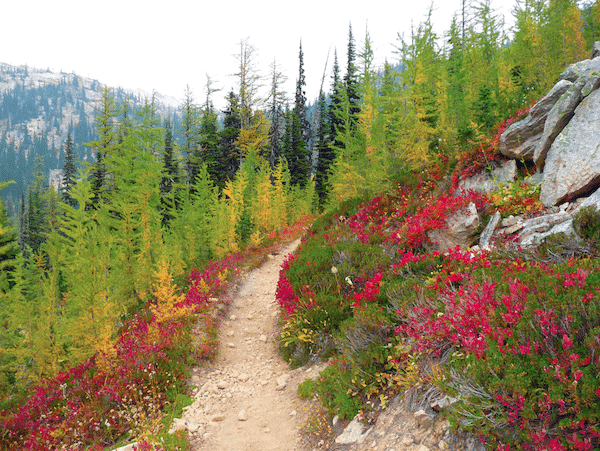
The Pacific Coast Trail. (Photo by Shutterstock)
Make it doable
Although many dream of hiking the entire trail, it’s impractical for most people because of the time and sheer endurance needed to accomplish this — especially if you want to do it with your dog. Small sections of the trail are another story, though. You and your dog can experience part of the Pacific
Crest Trail on a simple day hike or over a few days.
Oregon-based veterinary technician Melissa Spencer writes a blog about hiking with dogs called TheHikingTreeBlog.wordpress.com and has hiked sections of the Pacific Crest Trail with her Border Collie mix, Sage.
“Many of the sections of the Pacific Crest Trail through Oregon and Washington are good for hiking with a well-conditioned dog,” she said. “For one, the national parks the Pacific Crest Trail travels through in these states allow dogs on the Pacific Crest Trail corridor. For another, access to drinking water is not as limited there as in other places. And it generally isn’t overwhelmingly hot in most sections of Washington or Oregon along the Pacific Crest Trail.”
Hiking even small sections of the Pacific Crest Trail with a dog can be great fun, but overnight hikes require planning, especially concerning food and water.
“That is the daily challenge of hiking with a dog,” Melissa said. “Both food and water are very heavy, and you don’t want your dog to carry more than about 25 percent of his body weight.”
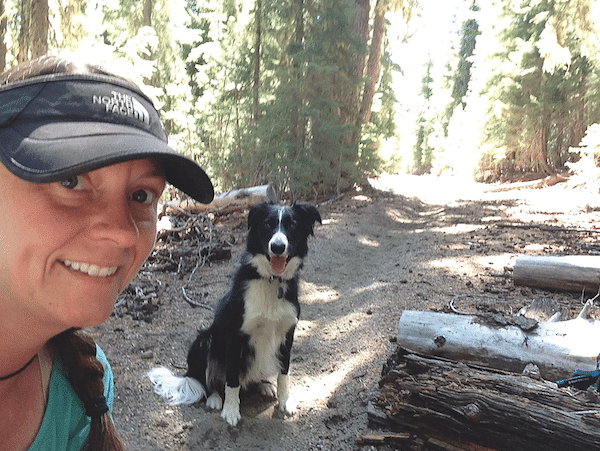
Melissa and Sage. (Photo courtesy Melissa Spencer)
Pointers from Melissa
- Many dogs don’t do well with quick diet changes, so have your dog’s food sent to you if you are doing a really long section.
- Increase your dog’s daily caloric intake by 50 to 100 percent, so he doesn’t lose too much weight.
- Think about using freezedried dog food or energy bars made specifically for dogs to add calories and reduce bulk.
- Be vigilant about knowing where the next water source is and how much water your dog drinks.
Going the distance
Although it can be tempting to take your dog on a long backpacking hike on the Pacific Crest Trail, this is an adventure best left for experienced long-distance hikers and well-conditioned dogs. Hiking long distance with a dog can pose problems
When Sage is on a long trail with me, it’s like a constant challenge,” Melissa said. “It has its rewards in that I get to be with my baby, but there are challenges. Like the time I had to hike early in the morning and get to the next river where I could get Sage cooled off before he got heatstroke. Or the time he hurt his hip misjudging a jump over a cattle guard, and I had to cut my hike short. Or the time he started chasing a bear down the trail within five minutes of starting our hike.”
When planning a hike on the Pacific Crest Trail, research the section you want to visit, and consider the time of year. The desert sections of Southern California are best visited in the winter, while the higher elevations in the central and northern parts of the state are better in summer.
“My favorite time of year to hike most parts of the Pacific Crest Trail from Northern California north are in August and early September,” Melissa said. “The snow should be melted out, the mosquitoes should be dying down, and the larches are turning. The one added caution at that time of year is that this is also huckleberry season, and the bears are more visible. But I always recommend keeping your dog close to you.”
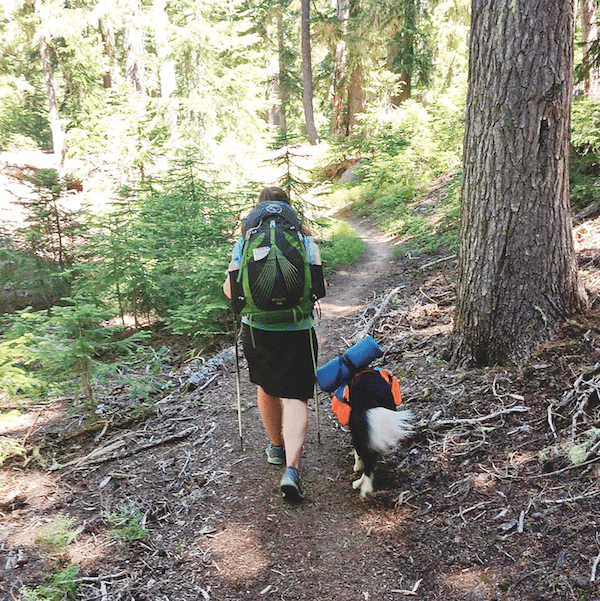
Melissa and Sage. (Photo courtesy Melissa Spencer)
The PCT at a glance
The Pacific Crest Trail is a true wonder that allows visitors to see some of the most beautiful sections of the West. Here are some key points about the trail:
- Starts at the Mexican border and ends 12 miles past the Canadian border
- Spans a total of 2,650 miles
- Passes through seven national parks
- Meanders through deserts, forests, and mountain ranges
- Goes from sea level to 13,153 feet
- Dogs and horses are allowed on most of the trail.
Break it down
Summary of the sections of the Pacific Crest Trail:
- Southern California — The trail begins near the town of Campo by the Mexican border at an elevation of 2,915 feet. It reaches 9,030 feet in the San Jacinto Mountains, then reaches a low point of 1,190 feet at the San Gorgonio Pass. It eventually enters the Sierra Nevada Mountains.
- Central California — This section begins at Walker Pass, at an elevation of 5,246 feet. It passes between expansive meadows and conifer forests, then rises 3,300 feet to Cottonwood Pass. The trail passes through Sequoia National Park and Yosemite National Park.
- Northern California — Starting north of Donner Summit at 7,989 feet, this part of the trail goes through Lassen Volcanic National Park, along with miles of national forest.
- Oregon — The trail starts with Siskiyou Summit at 4,310 feet in southern Oregon and is the shortest and easiest section of the Pacific Crest Trail to hike or ride. The trail passes prominent volcanoes and
myriad lakes. It also cuts through Crater Lake National Park. - Washington — The Washington section of the trail begins at the Bridge of the Gods, at 180 feet, and ends at Monument 78 on the Canadian border at 4,240 feet. Before it reaches Canada, the trail crests near the Indian Heaven Wilderness, then rounds the base of Mount Adams, which stands 12,276 feet. The trail passes many lakes and eventually approaches Mount Rainier, at 14,410.
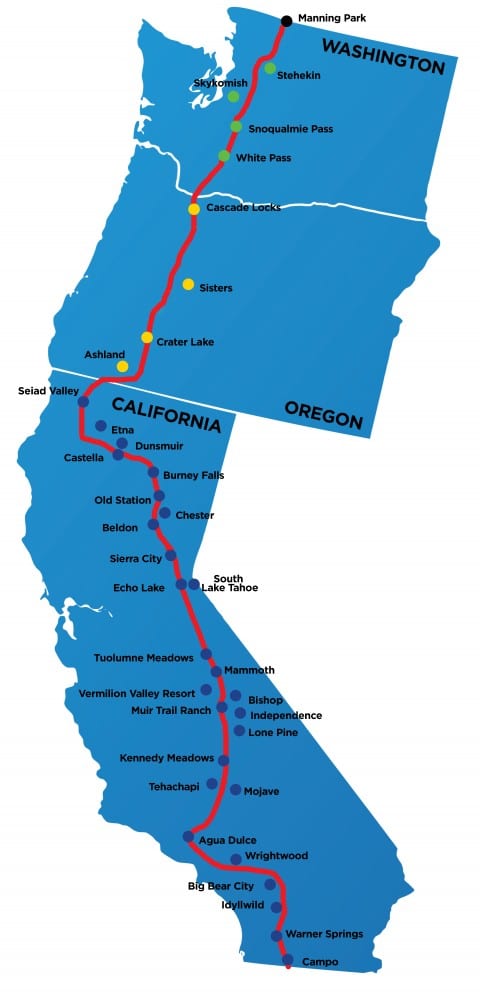
Day hike essentials
When going on a small hike with your pooch, don’t forget these must-have items:
Portable water bottle — Streams on hiking trails contain contaminants that can harm your dog. Bring extra water so he drinks safe, clean water. Some water bottles come with a detachable bowl, allowing you and your dog to share the bottle! 600 ml OllyBottle/$11.99; ollydog.com
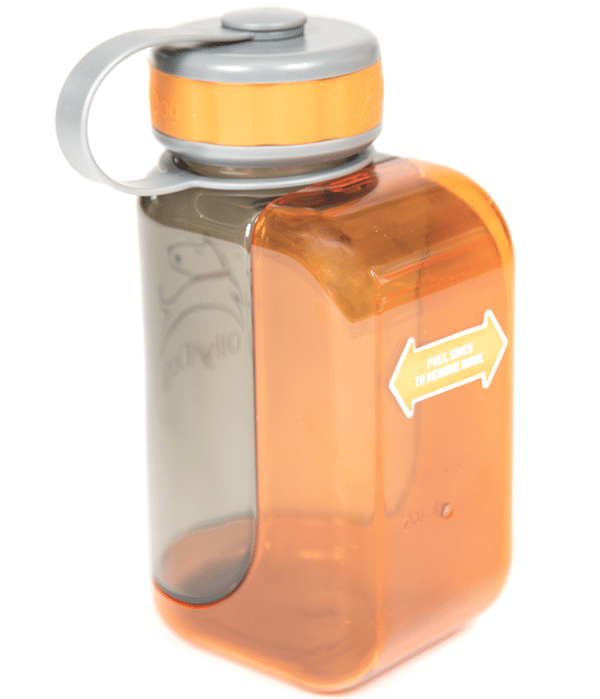
Energy/snack bars — Your dog will burn more calories than usual, so pack extra food to keep him energized. Snack bars will give your dog required nutrients, and they’re easy to carry. Dog for Dog Dogsbar/$3; dogfordog.com

Doggie backpack — Depending on your dog’s size, you can count on him to carry the load! He shouldn’t wear a backpack that’s more than 25 percent of his body weight. First check with your veterinarian before placing a load on your dog. EZYDOG Saddle Bag, S/$55; ezydog.com
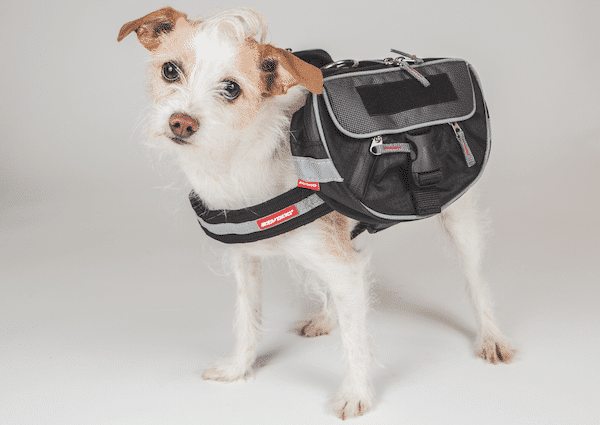
EZYDOG Saddle Bag. (Photo courtesy EZYDOG)
Leash and harness — Keep your dog safe and close by. EzyDog Convert Harness, M/$64; EzyDog Vario 4 Multi-Function Leash/$25; ezydog.com
The post How to Hike the Pacific Coast Trail With Your Dog appeared first on Dogster.
No comments:
Post a Comment